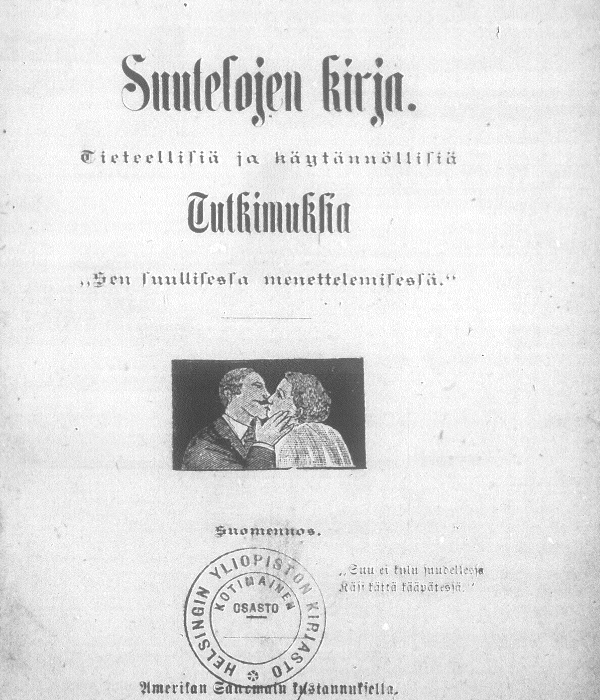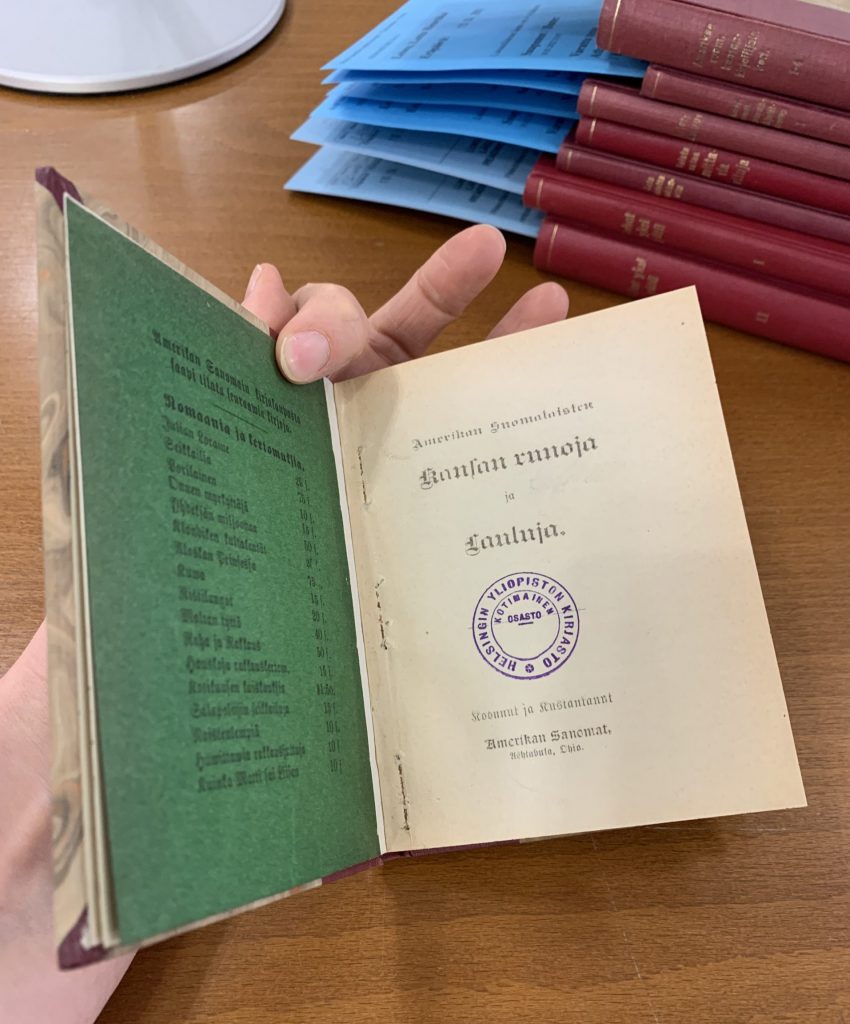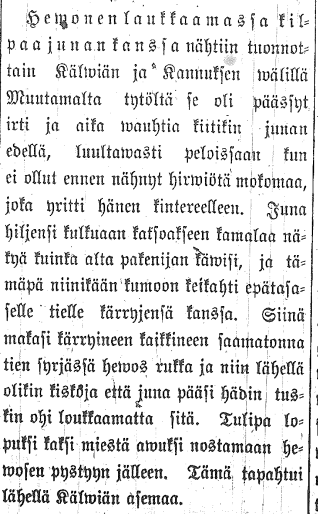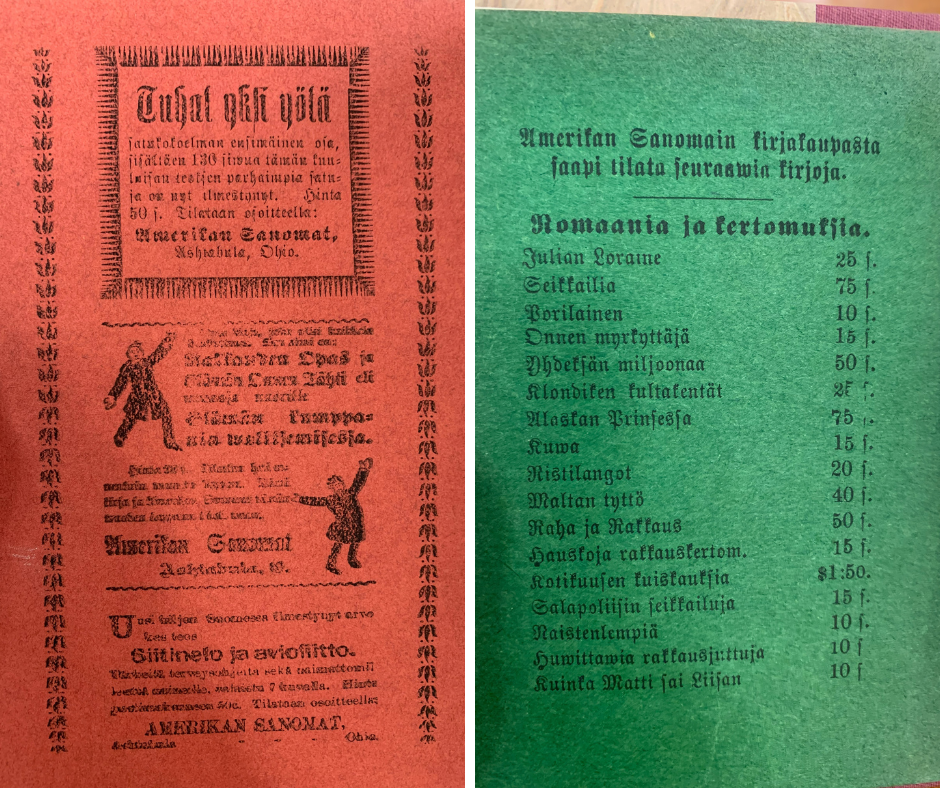Author: Lotta Leiwo
Newspaper Symposium 2022: New Exciting Finds from the Archive
Our PI Kirsti Salmi-Niklander and I, research assistant Lotta Leiwo attended the Newspaper Symposium organized by National Library of Finland on 30 August 2022. The day was full of interesting presentations by researchers from various fields from history, literature, ethnology to folklore studies.
In our presentation ‘Finnish American newspapers – benefits and challenges of digital and physical materials’ we discussed about Finnish American publishing, it’s relations to our project and presented our T-Bone Slim project to the audience both on site and online. As we have already discussed on our blog, American Finnish publishing in Ashtabula was lively already from 1880’s.
Our presentation in Newspaper Symposium was based on the corpus of material from the research project which focuses on the Finnish immigrant community and includes the Finnish-language newspapers Pohjantähti (1886-1887) and Amerikan Sanomat (1897-1913) published in Ashtabula, Ohio. The early newspaper publications provide opportunities to examine the daily lives, communities, and networks of Finnish immigrants at the turn of the century. In our presentation, we discussed our methodology with the newspaper material and the solutions we have adopted. Some Finnish American newspaper materials are available digitized in the Chronicling America database of the Library of Congress (LOC), but the newspapers in our corpus are only available as microfilm copies or as physical copies in the National Library of Finland. This means that the material has to be studied using more “traditional” methods, and that, for example, quick word searches are not possible as is on digitized materials. At the same time, the existing digital Finnish newspaper database provides valuable reference material, allowing us to examine, for example, the folklore texts in our materials and the networks of texts published in several journals.

The hybrid nature of our data corpus and the manual nature of our work offer both benefits and challenges for research. Going through the material manually is a prerequisite for conducting qualitative analysis – at the same time, the time spent collecting, processing and transcribing the non-digital materials takes time away from other research work. However, browsing physical copies of newspapers gives tangible understanding compared to the more distant digital material. Physical copies of magazines also provide an opportunity to get a feel for the reader’s experience. In our case we were able to find a gem: possibly one of the texts T-Bone Slim might have published in Finnish. Previously there has not been record of T-Bone Slim writing in Finnish or knowledge whether he could write in Finnish at all. This text was written by another pseudonym we knew he used later: “Mathew Houghton” in Amerikan Sanomat 1.1.1903.
Mathew Houghton’s text is correcting a previous correspondence letter from Erie, Pennsylvania published in Amerikan Sanomat. Mathew Houghtons letter was sent to the editorial staff of Amerikan Sanomat, and printed in the last page of the paper where they had a column for “local news”. Additionally, the text is describing a Christmas party of the temperance society “Tyyni”. We were restrainedly enthusiastic with the find but were not 100 % certain this was “our T-Bone”. Literally, as I was finalizing this text yesterday, I ended up turning few more stones to find out more about Tyyni Temperance Society. We have just found out that some of the American Finnish periodicals are actually digitized on National Library of Finland’s database, so I did some searches with different search terms. After a while I was able to find a true gem from Raittiuslehti : Raittiuden Ystäväin Äänenkannattaja [Temperance Paper: Organ of the Friends of Temperance], 25.5.1899:

Translated text:
“Tyyni Temperance Society’s officers are as follows; agent* Matti W. Huhta, chairperson Petti Lakari, keeper of the minutes Otto Ranta, treasurer J. Erkkilä, servant mrs Hietikko, [hall] caretaker E. Suutala, aid for keeper of the minutes miss Ida Huhta, servants aid miss Katri Lakari. W. Erie”
*Agent probably means a correspondence officer for the publication Raittiuslehti : Raittiuden Ystäväin Äänenkannattaja as the address of “Math. W. Huhta” is available on another page of the publication where all the local correspondents of Suomalainen kansallis-raittius-veljeysseura [Finnish National Temperance Fraternal Society] are listed. The address has a typo, but is the same where T-Bone’s parents Matti and Johanna Huhta had a boarding house at the time (mentioned also on another blog entry here). Apparently, also T-Bone’s sister Ida Huhta was an active member of the Tyyni Temperance Society.
In this case we can be quite certain that this person is “our T-Bone” and it confirms the text written by “Mathew Houghton” is his writing, too. Both texts give us important information of people he worked with and the networks he had. This is truly a significant find as we now have evidence of T-Bone Slim also writing in Finnish. Tyyni Temperance Society is known publishing a monthly hand-written newspaper (see ‘Overview of the Activities of the Tyyni Temperance Society’ in Valoa : amerikan suomalaisen raittiuskansan kesäjulkaisu [Light: American Finnish Temperance Folk’s Summer Issue], 01.01.1938, p. 20, text is in Finnish), could T-Bone have written in that paper? Hopefully we are able to find Tyyni’s “Nyrkkilehti” [Fist Press], as the hand-written newspapers were often called, somewhere to study this topic further!
This topical find is even better example of how we have conducted research on our different research materials, than we were able to provide on our presentation at Newspaper Symposium. This also gives an example how our work is in a really interesting phase right now. We find something exciting almost every day and have several leads from physical, actual newspapers, periodicals and journals that are kept in several archives. With these leads we can do comparative research on digitized materials. Currently, we are working on with several interesting leads and topics concerning T-Bone Slim’s text’s, intertextuality, and his networks.
It seems that the Newspaper Symposium keeps on giving. Besides networking with other researchers and discussing future research prospects, we were able to find new materials that illuminate early years of T-Bone Slim with the inspiration we got from others!






